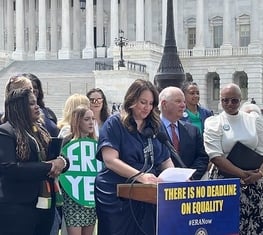Redistricting Glossary
Apportionment: The process for allocating representative seats within a geographic area or political jurisdiction according to changes in population. For example: Seats in the United States House of Representatives are distributed among the 50 states according to each new Census, with states that gain population receiving more seats and those that lose population getting fewer.
At-large: When a district elects more than one member, all candidates run against each other on one ballot, and they are elected by the whole population of the district.
Ballot measure: A ballot measure is a piece of proposed legislation to be approved or rejected by eligible voters. Ballot measures are a form of direct democracy, as opposed to legislation passed by representatives. Ballot initiatives, proposals, and referendums are all types of ballot measures.
Ballot initiative or referendum: A certain percent of voters is needed to validate a measure and be accepted on the ballot in an election. That number varies based on state and the number of signatures needed to get a ballot measure on the ballot. Also applies to referendums.
Campaign: An organized, purposeful effort to create a particular change.
Census: A complete count or enumeration of the population; the federal census is mandated by the U.S. Constitution in Article 1, section 2. Since 1988, the League has worked with state and local Leagues to encourage full participation in the census and to ensure that subsequent reapportionment and redistricting complied with one-person, one-vote requirements and the Voting Rights Act.
Census block: The smallest and lowest level of geography defined for decennial census tables. The Census Bureau provides redistricting data down to the block level, which is the lowest level of census geography. Blocks can have any population, including no people.
Census Bureau: The government agency responsible for the United States Census and gathers other national demographic and economic data. As part of the United States Department of Commerce, the Census Bureau serves as a leading source of data about America's people and economy.
Census tract: Set of block groups combined to create a unit of census geography delineated by local committees in accordance with census bureau guidelines for the purpose of collecting and presenting decennial census data.
Civic engagement: The process of working to make a difference in the civic life of communities and developing the combination of knowledge, skills, values and motivation to make that difference. The promotion of improved quality of life in a community occurs through both political and non-political processes.
Commission: A statutory or constitutional body charged with researching, advising or enacting policy. Redistricting commissions have been used to draw districts for legislatures and Congress.
Communities of interest: Areas defined by shared socio-economic, ethnic, geographic, economic or other interests. The definition should not include any relationship between a community and a political party, incumbent or candidate.
Compact: The notion that a district should not have an odd shape, as is often the case with a gerrymandered district. Having the minimum distance between all the parts of a constituency (a circle, square or a hexagon are examples of very compact district). There are a number of different ways for measuring compactness, including the dispersion model which measures the distance of the borders from a central point and the perimeter-area model which provides a ratio of the perimeter to the area for comparison among districts.
Competitive district: A district where candidates of more than one party have a realistic chance of winning election. Mathematically the formula used for competition is generally 50% +/- 3.5% meaning a range of 46.50% - 53.50%.
Coalition: An alliance for combined action, especially a temporary alliance of political parties forming a government or of states.
Contiguous: All parts of a district must be connected, usually by land, and connected by more than a single point.
Cracking: Spreading supporters of a particular party or members of a minority group across multiple electoral districts so as to prevent them from being able to elect their favored candidates.
Criteria: The standards on which a redistricting plan is based and should be judged must: (1) be enforceable in court; (2) require substantially equal population; geographic contiguity; and effective representation of racial and linguistic minorities. Criteria should also provide for promotion of partisan fairness, preservation and protection of “communities of interest” and respect boundaries of municipalities and counties. Compactness and competitiveness can be considered if it doesn’t conflict with the above criteria. Redistricting plans should explicitly reject protection of incumbents and preferential political party treatment.
Dilution: Reduction in the voting strength of a group within a redistricting plan. The phrase "minority vote dilution" describes racial minorities being in a position of not being able to elect candidates of choice.
District: The boundaries that define the constituency from which a public official is elected.
Federal legislative fixes: Federal legislative fixes for this campaign are bills passed by the U.S. House and Senate and signed by the President, which create a fix for gerrymandering nationwide. Examples of qualifying legislation include the For the People Act and the Voting Rights Advancement Act.
Gerrymandering: A term of art coined in early 19th century to describe a plan or a district intentionally drawn to advantage one group or party over another, sometimes identified by bizarre shapes.
- Incumbent protection gerrymandering: Drawing safe district boundaries that include an incumbent’s residence so as to assure his/her re-election.
- Partisan gerrymandering: Drawing voting districts that give unfair advantage to one political party, group or incumbent. In Vieth v. Jublierer (2004), the Supreme Court of the United States ruled that excessive partisanship in redistricting is unconstitutional but did not state a standard for determining what is excessive.
- Bipartisan gerrymandering: The drawing of safe districts by two political parties to mutually protect their political interests and their incumbent members.
- Prison-based gerrymandering: Including prison populations in the calculations of a district’s population, despite the fact that inmates are rarely constituents of the areas where they are housed. Especially in rural districts that include large, disenfranchised prison populations, the ballots of the voters of those districts thus hold a disproportionate weight.
GIS: Geographic Information System. Computer software used for creating or revising plans and analyzing geographically oriented data.
Independent, or nonpartisan: Because groups and communities use different terms to mean ‘independent’ and ‘nonpartisan’, we include a list of what may be considered synonyms for those words in this context. Leagues may want to use different terms depending on their communities, though we need to be aware of the importance of language. Words used in various states and by various groups to describe kinds of commissions:
- Independent: A process that is independent from the legislature and that operates outside of partisan control and interests.
- Nonpartisan: Like independent, a process that operates outside of partisan control and interests.
- Party-neutral: Like independent, a process that is independent from partisan control.
- Partisan: A process that is controlled by the major parties in the area being redistricted.
- Bipartisan: implies two, but many people also think it means ‘fair’.
Independent redistricting commissions: The League supports independent redistricting commissions as the most transparent and responsible way to draft and implement electoral district maps. Independent restricting commissions should consist of membership that reflects the diversity of the unit of government, including citizens at large, representatives of public interest groups, and members of minority groups.
Legislative body: Any entity that performs governmental legislative duties and whose membership is elected by the people; aka representational body.
Minority-majority districts: A legislative district where a racial, ethnic or language minority makes up the majority of the population.
Multi-member district (aka ‘at-large’ or multi-seat district): A district where the voters elect candidates to fill two (2) or more seats in the same “district.”
One person, one vote: The standard set by the U.S. Supreme Court in Reynolds v. Sims (1964), which generally requires that each legislative district include an equal number people. Chief Justice Warren said “Legislators represent people, not trees or acres. Legislators are elected by voters, not farms or cities or economic interests.”
Packing or stacking: Drawing districts so a group—opposite political party, minority—is heavily in one district and thinly represented in other adjoining districts. This process allows the party in power to weaken the opposition by wasting their votes in the packed district.
Proportional Representation (PR): A voting system in which groups of voters with similar interests gain representation in “proportion” to their voting strength. There are many styles of PR.
Partnerships: An association of two or more individuals or a group coming together for a shared goal or outcome around redistricting reform relevant to their state and communities.
Population: The total number of people, including noncitizens and children, who reside in a jurisdiction.
Power Mapping: The process of creating a visual chart to identify the best individual targets to advance our goals. Power mapping determines who the decision makers are in the community that are required to build momentum. It also identifies who are the people who can influence the decision makers and move them in our direction.
Public participation: Any individual or group activity working to address an issue or multiple issues of public concern.
Reapportionment: The reallocation of the number of representative seats within a set of geographic areas or political jurisdictions, based on changing populations.
Redistricting: The process of crafting new boundaries for representational districts.
Safe district: A district drawn so that no other political party or other group is likely to have a chance of electing a representative for the district.
Single Member District (SMD): A district where there is only a single winner or a single open seat; also known as "winner-take-all." It is the most common type of district used in the United States.
State constitutional options: These options are court cases that challenge the practice of gerrymandering or establish fair redistricting reform based on a “free and fair” clause in a state’s constitution. Cases like LWVPA v. Commonwealth give hope for the state-level fight for fair elections. When the League challenged Pennsylvania’s congressional districts as unconstitutional under their state constitution, the Pennsylvania Supreme Court ruled in their favor. The use of Pennsylvania’s state constitution established a framework for a state constitutional standard to measure extreme partisan gerrymandering. With this framework, partisan gerrymandering can be battled out in state courts by leveraging similar constitutional clauses
State legislative fixes: This is a fix through state legislative bodies that will establish fair redistricting processes in the state. LWV will track state legislation that could advance or hinder the redistricting process. Where there are productive bills that make redistricting more transparent, the League will work to advance that legislation. Where there are bills that shorten the window for a map, limit public content (other bad things), the League will work to fight such legislation. Making sure implementation of redistricting is protected. In this fix, Leagues will testify on the redistricting process. Any tinkering of the process will happen in early 2020 – drawing of the lines and implementation FY21, first quarter 2021. Leagues will call for transparency, an open process, and prohibition of lobbyist influence.
Super District: A term generally used to refer to a multi-member district (MMD) designed during a districting (or redistricting) process which consolidates the areas of several smaller single member districts. Each super district must still adhere to constitutional requirements of equal apportionment and protect the equal rights of voters, including minority voters.
Transparency: Mechanisms by which the public can obtain information about government operations so that they can hold governments accountable. (http://www.brookings.edu/about/projects/transparency-accountability.)
Voting Rights Act (VRA): The Voting Rights Act, also known as the VRA, was enacted by Congress in 1965 (42 U.S.C. 1973 to 1973bb-1) and transformed elections in the U.S. by prohibiting racial discrimination in voting. Pursuant to the VRA, the Attorney General undertakes investigations and litigation throughout the United States and its territories, conducts administrative reviews of changes in voting practices and procedures and monitors elections. The Act has been amended several times over the years, and in 2013, a portion of it was struck down by the Supreme Court. (See FAQs for more in-depth information about the VRA.)
Unity Maps: Where multiple organizations with different interests come together during a redistricting cycle to either create a mutually-agreeable map for presentation and submission as part of the redistricting process or where groups work together to identify the best map to accomplish a shared goal as part of the redistricting process.
Sources include: Impact on Issues (LWVUS), NAACP, MALDEF (Mexican American Legal defense and Educational Fund), Brennan Center for Justice, League of Women Voters of California, League of Women Voters of Oregon, U.S. Department of Justice, Azavea, Wikipedia. See NTF Websites for the websites of these organizations.




